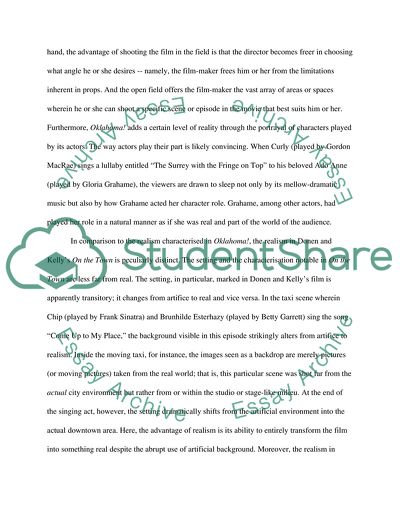Cite this document
(Transition from Stage to Screen Essay Example | Topics and Well Written Essays - 2000 words, n.d.)
Transition from Stage to Screen Essay Example | Topics and Well Written Essays - 2000 words. Retrieved from https://studentshare.org/visual-arts-film-studies/1752308-in-adapting-broadway-musicals-for-the-cinema-filmmakers-have-tended-to-either-champion-artifice-or-champion-realism-analyse-the-advantages-and-disadvantages-of-these-two-approaches-in-the-transition-of-the-musical-from-stage-to-screen-with-close-refere
Transition from Stage to Screen Essay Example | Topics and Well Written Essays - 2000 words. Retrieved from https://studentshare.org/visual-arts-film-studies/1752308-in-adapting-broadway-musicals-for-the-cinema-filmmakers-have-tended-to-either-champion-artifice-or-champion-realism-analyse-the-advantages-and-disadvantages-of-these-two-approaches-in-the-transition-of-the-musical-from-stage-to-screen-with-close-refere
(Transition from Stage to Screen Essay Example | Topics and Well Written Essays - 2000 Words)
Transition from Stage to Screen Essay Example | Topics and Well Written Essays - 2000 Words. https://studentshare.org/visual-arts-film-studies/1752308-in-adapting-broadway-musicals-for-the-cinema-filmmakers-have-tended-to-either-champion-artifice-or-champion-realism-analyse-the-advantages-and-disadvantages-of-these-two-approaches-in-the-transition-of-the-musical-from-stage-to-screen-with-close-refere.
Transition from Stage to Screen Essay Example | Topics and Well Written Essays - 2000 Words. https://studentshare.org/visual-arts-film-studies/1752308-in-adapting-broadway-musicals-for-the-cinema-filmmakers-have-tended-to-either-champion-artifice-or-champion-realism-analyse-the-advantages-and-disadvantages-of-these-two-approaches-in-the-transition-of-the-musical-from-stage-to-screen-with-close-refere.
“Transition from Stage to Screen Essay Example | Topics and Well Written Essays - 2000 Words”. https://studentshare.org/visual-arts-film-studies/1752308-in-adapting-broadway-musicals-for-the-cinema-filmmakers-have-tended-to-either-champion-artifice-or-champion-realism-analyse-the-advantages-and-disadvantages-of-these-two-approaches-in-the-transition-of-the-musical-from-stage-to-screen-with-close-refere.


